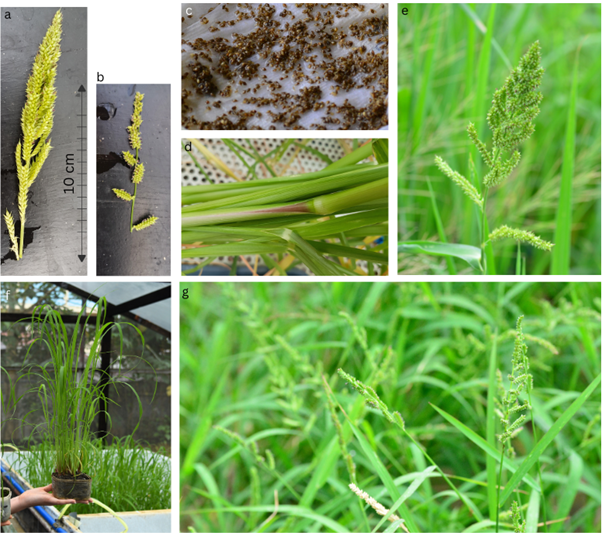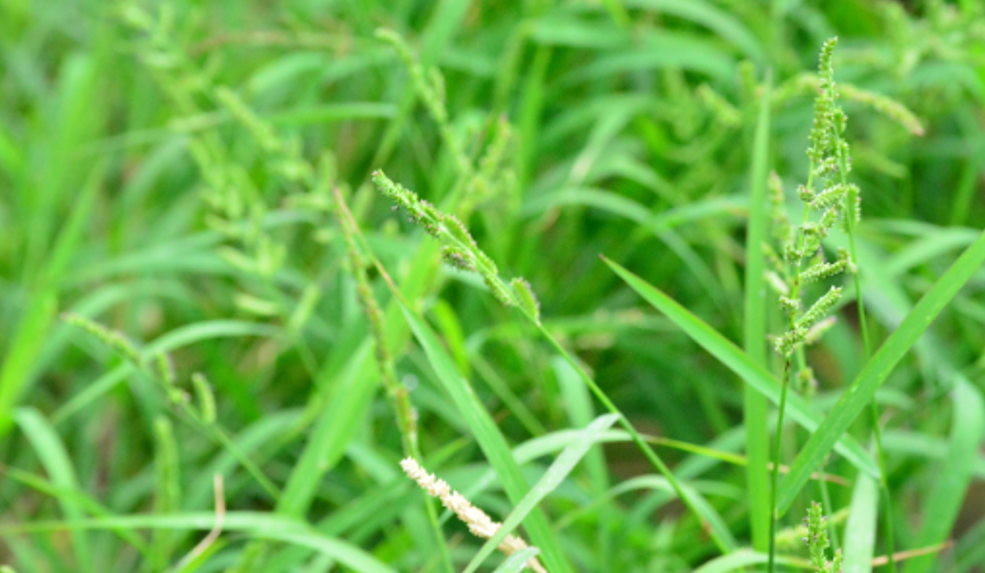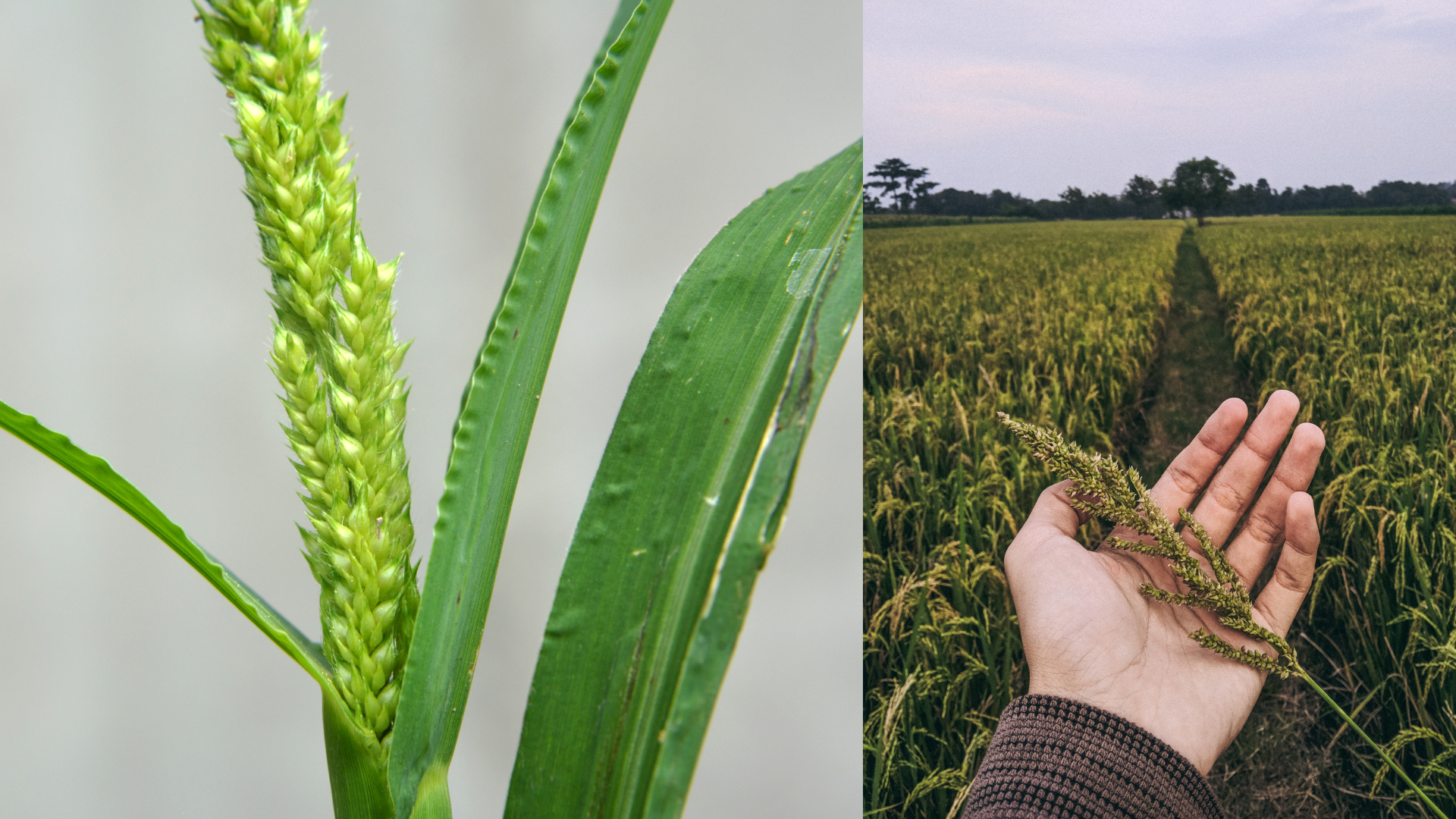Echinochloa: How to control one of the most economically important weeds globally
The Echinochloa genus (barnyard grasses) is native to tropical and warm temperate regions. Plants of that genus are spread worldwide, able to establish and grow in various environments, and survive a great variety of environmental changes. They are responsible for high yield reduction in different crops and are challenging to manage. What is Echinochloa?
Echinochloa: Plant Information
The genus Echinochloa (barnyard grasses) belongs to the family Poaceae (grasses) and subfamily Panicoideae, encompassed in the monocot clade. It includes 40–50 annual and perennial species. The genus name is derived from the Greek words “echinos” meaning hedgehog, and “chloa” meaning grass, about the spikelets with hard hairs presented by several species.
Some species within this genus are millets that are grown as cereal or fodder crops (Clayton & Renvoize, 2006). It is the case for:
- the Japanese barnyard millet (E. esculenta) in East Asia,
- the Indian barnyard millet (E. frumentacea) in South Asia,
- the Burgu millet (E. stagnina) in West Africa.
Most of the other species are not cultivated and are considered weeds (unwanted plants). The most common and detrimental Echinochloa weeds that are found worldwide and in different crops are:
- the barnyard grass or cockspur grass (E. crus-galli (L.) P. Beauv.),
- the jungle rice (E. colona (L.) Link),
- the late watergrass (E. oryzicola Vasinger or E. phyllopogon (Stapf) Stapf ex Kossenko).
Few others Echinochloa are mainly detrimental in rice fields and to a lesser extent:
- the early barnyard grass (E. oryzoides),
- the barnyard grass (E. glabrescens),
- the gulf cockspur grass (E. crus-pavonis).
Why is Echinochloa such an important weed?
E. crus-galli is the most prevalent species (Yabuno, 1983), followed by E. colona. Those species were ranked as the world’s third and fourth worst weeds, respectively (Holm et al., 1991). E. crus-galli has been classified again as the third-worst weed in modern agriculture (Leeson et al., 2005; Heap, 2014; Kraehmer et al., 2016), and both E. crus-galli and E. colona are cited among the 12 most troublesome weeds of rice in Asia (knowledgebank.irri.org).
The major crops affected by E. crus-galli (Cockspur grass) and E. colona (jungle rice) are mainly cereals:
- especially rice (Oryza sativa L.) and maize (Zea mays L.), but they also affect
- barley (Hordeum vulgare L.),
- sugarcane (Saccharum offcinarum L.),
- wheat (Triticum aestivum L.),
- cotton (Gossypium hirsutum L.),
- mungbean (Vigna radiate (L.) R. Wilczek),
- sorghum (Sorghum bicolor L.),
- peanut (Arachis hypogea L.),
- cassava (Manihot esculenta Crantz),
- soybean (Glycine max (L.) Merr.) (Holm et al., 1991; Rao et al., 2007; Kraehmer et al., 2016; Shabbir et al., 2019).
They can also affect vegetable and root crops, orchards, and vineyards (Holm et al., 1991; Von Redwitz et al., 2016).
Echinochloa plants are found in diverse ecosystems, ranging from dry to wetlands, and are scattered across both warm and temperate regions. Species of that genus have great adaptability to environmental changes (Bajwa et al., 2015).
These weeds can cause significant damages to the planted crop (yiled losses) due to their rapid growth and high competitive ability for space, light, water, and especially nutrients (Holm et al., 1991; Bastiaans et al., 2008). In addition, they can serve as hosts for nematodes insects and for several cereal diseases such as tungro virus, rice yellow dwarf virus, maize sterile stunt virus, and maize yellow stripe virus (Rojas-Sandoval & Acevedo-Rodríguez, 2014). E. colona can also suppress the germination or growth of rice by allelopathic effects (Sitthinoi et al., 2017; Khanh et al., 2018).
Another important problem it causes is the contamination of the purity of harvested grains. Echinochloa can produce large quantities of seeds that can stay dormant in the soil for 8-9 years (Chul & Moody, 1989). Consequently, its propagation and seed bank build up in the fields over time (Gibson et al., 2002; Clay et al., 2005).
The yield losses caused by E. crus-galli range between 21 and 79 % depending on the areas, the soil composition, the seed bank, the climate, the cropping system, and weed management (Stauber et al., 1991; Ottis & Talbert, 2007; Wilson et al., 2014; Bajwa et al., 2015). In other studies, E. colona showed a decrease in direct-seeded rice yield by up to 76% (Chauhan & Johnson, 2010), and E. oryzicola showed a decrease in rice grain yield by 49% (Yamasue, 1997).
How to recognize Echinochloa?
Echinochloa are annual, C4, monocot grass plants. In the first weeks, the plants have a similar size and color to the rice, with few leaves, more or less erect, 2 to 5 times longer than wider, with pointed ends. Their ability to mimic the rice at the vegetative stage makes it very difficult to recognize and remove Echinochloa seedlings from the field by hand weeding. Echinochloa plants start to form tillers at the same time as rice plants, but they complete their cycle (seed germination to seed production) earlier than most rice varieties (in average, 50-60 days).
At a later stage, E. crus-galli and E. colona plants:
- The plant can grow up to 1.5-2 m in height, with a maximum stretched length of up to 3.6 meters for E. crus-galli, and can measure up to 1 m for E. colona.
- New stems (tillers) grow in clumps by rooting and branching at the lower nodes of the existing stems. Stems are flattened at the base, cylindrical, without hairs, and filled with white spongy pith (aerenchyma tissue). Most stems are upright, but some spread out over the ground.
- They present long, linear, erect, and flat leaves, with blades of 10-40 cm long for E. crus-galli, and 10-25 cm long for E. colona. Leaves have a broad, round base, often reclined and purplish/reddish, narrow top, and do not show either ligules or hairs.
- The inflorescences (panicles) are ascending, about 10−25 cm long for E. crus-galli, and 2-12 cm long for E. colona. They are composed of about 5-15 cm long ovoid spikes of pale green to purple color, carrying crowded spikelets more or less elliptical and pointed, usually slightly hairy, and can have green to purplish awns of 2-5 mm long.
- The large millet-like seeds are of 1.5-3 mm.
- The roots of well-developed plants are fibrous, white or brown and can reach to more than 1 m soil depths. New roots can grow where tillers touch the ground. Adventitious roots are formed in wetlands.(cals.cornell.edu; dijon.inrae.fr; knowledgebank.irri.org; feedipedia.org)

Pictures of different stages of Echinochloa to help the identification.
a. and b. Late inflorescence of E. crus-galli (a) and of E. colona (b) grown in greenhouse, (differences in spikes shape and inflorescence size); c. seeds of E. crus-gall; d. Leaves (no ligules, no hairs) and stem (rounded and purplish at the node level) of E. crus-galli ; e. Inflorescence of E. crus-galli in the field, f. The vegetative stage of E. crus-galli plants (about 3 weeks old) grown in a pot in the greenhouse; g. E. colona presence in a fallow field (Pictures from J. M. Toulotte).
How to prevent its growth and to control its infestation?
Prevention strategies:
To efficiently decrease the population of weeds in the field, whether the crop is present or not, the first action is to reduce the soil’s weed seed bank. That is why the earliest control, before the weeds start producing seeds, is the best. Echinochloa propagates mainly by seeds. Plants can flower all year round and produce seeds within 60 days. Each Echinochloa plant can produce up to 40,000 seeds per year. Dispersion of the seeds can occur via water, birds, insects, animal feet, and machinery, but contaminated crop seed is probably the most common dispersal method. Therefore, farmers must use free-from-weed seed material and utilize cleaned and disinfected machinery in their fields. The land should be prepared before the next cultivation: let the weeds emerge for at least two weeks so that you can plow the land and repeat tillage at adequate (~10-day) intervals to effectively eliminate both weeds and residual stubble from the prior crop (knowledgebank.irri.org).
Manual or mechanical weeding:
- Before seeding the crop, cleaning the field from outed weeds, manually or mechanically, is necessary.
- Due to its phenotypic similarity to rice, manual weeding of Echinochloa, at the vegetative stage, is difficult. Manual weeding is also more expensive than chemical control and more time-consuming.
- Remove weeds in uncultivated fields to prevent flowering, seed formation, and the accumulation of weed seeds in the soil. Also, the weeds staying in fallow fields facilitate the survival of pests.(knowledgebank.irri.org)
Chemical control – Herbicides:
Chemical control methods are the cheapest option for farmers but not the most ecological choice. Furthermore, Echinochloa weeds developed resistance to many molecules used worldwide.
Resistant E. crus-galli populations have been recorded in different countries to different active compounds: the ALS (acetolactate synthase) inhibitors, including the chemical groups of imidazolines and triazolopyrimidines-2, ACCase (acetyl CoA carboxylase) inhibitors, and synthetic auxin herbicides largely used in rice fields (Heap, 2017; Fang et al., 2019).
In Brazil, the extensive usage of imidazolinones led to resistance to these herbicides only four years after their first usage (Merotto et al., 2016).
In France, Canada, and the US, resistant populations of this weed to triazine herbicides have also been recorded (dijon.inrae.fr). E. colona has shown varied degrees of resistance to selective and non-selective herbicides (glyphosate, atrazine, propanil, quinclorac, and metribuzin) in different crop systems and countries worldwide (Heap, 2017; Travlos et al., 2020). Two E. phyllopogon accessions in greenhouse dose-response studies suggested resistance to postemergence applications of molinate, thiobencarb, fenoxaprop-ethyl, and bispyribac-sodium, and this has been also observed in California, USA (Fischer et al., 2000; Heap, 2017)
Late herbicide application is another main reason for reduced control efficiency on weeds in rice crops (Fruet et al., 2020). Herbicides are more efficient when used before the crop is emerged. Here is a list of herbicides still advised by the International Rice Research Institute (IRRI, knowledgebank.irri.org) against the two major Echinochloa species in the rice field:
- For E. crus-galli: Oxadiazon, pretilachlor, pendimethalin or cyhalofop, thiobencarb, butachlor, and propanil mixtures with quinclorac or fenoxaprop.
- For E. colona: preemergence application of oxadiazon or pendimethalin or postemergence application of cyhalofop, butachlor, and fenoxaprop.
! ALWAYS read and follow the instructions on the product label and the guidelines of a licensed agronomist/extension!
Crop management:
Different cultural practices showed significant effects on reducing Echinochloa infestation:
- Rotate crops to break weed cycles
- Sow early to give a head start to the crop
- Sow with higher plant density with closer row spacing
- Select weed-competitive varieties with early seedling vigor and high tillering to suppress weeds by shading out the weeds (Chauhan & Johnson, 2010; Chauhan, 2013). Different rice varieties showed a reduction in E. crus-galli infestation in both dry fields and fields using water-based weed management, by their early vigor and providing early canopy closure. These varieties possessing specific traits/genes responsible for weed suppression could be a source for weed suppression by transferring these weed-suppressive traits into high-yielding breeding varieties (Huber et al., 2023).
- Flooding rice fields with about 2-5 cm water level in the field minimizes weed emergence and lowers weed pressure in later stages. Water management is efficient against E. colona. However, E crus-galli developed resilience to flooding, and it is therefore less efficient against this species (Ismail et al., 2012; Estioko et al., 2014; Bajwa et al., 2015; Kraehmer et al., 2016; Peralta et al., 2019; Kaspary et al., 2020).
Flooding also has disadvantages:
- the land shall be equipped for it, leveled, and weeded out 3−4 weeks before planting,
- rice plants must grow in nurseries and be transplanted into the field at the seedling stage, making this practice labor-, money- and time-consuming,
- much water is consumed, which is also costly, and it is not an ecological approach, as water resources in various places are becoming scarce,
- stagnant water provokes losses of soil nutrients and of applied fertilizers, contributing also to the eutrophication of the environment. Eutrophication in rice fields is an over-enrichment of the water with nutrients, especially nitrogen, causing an accelerated growth of algae, decreasing water quality, and increasing methane (CH4) emissions.
Flooding is still recommended in certain cases and in complement with the use of preemergence application of herbicides and other cultural practices. For example, combining an early phase of flooding in the field, and using high shade-casting rice varieties presented promising results (Toulotte, 2022).
- Fertilize just after weeding to minimize rice-weed competition for nitrogen and to increase early crop vigor. (knowledgebank.irri.org)
Biological control
The fungi Drechslera monoceras and Exserohilum monoceras might act as potential biocontrol agents of Echinochloa in rice fields (Zhang et al., 1996; Tosiah et al., 2010; Rojas-Sandoval & Acevedo-Rodríguez, 2014). The suitability of the mycoflora found on E. colona is also discussed as a biocontrol agent (Karuppiah & Seetharaman, 2006).
Conclusion
Echinochloa is a major challenge to farmers, as their infestation can result in significant economic losses. By implementing preventive measures and by acting mainly in the early stages of the crop, with chemicals and appropriate cultural practices, farmers can reduce its infestation, contamination, and yield losses.











































































